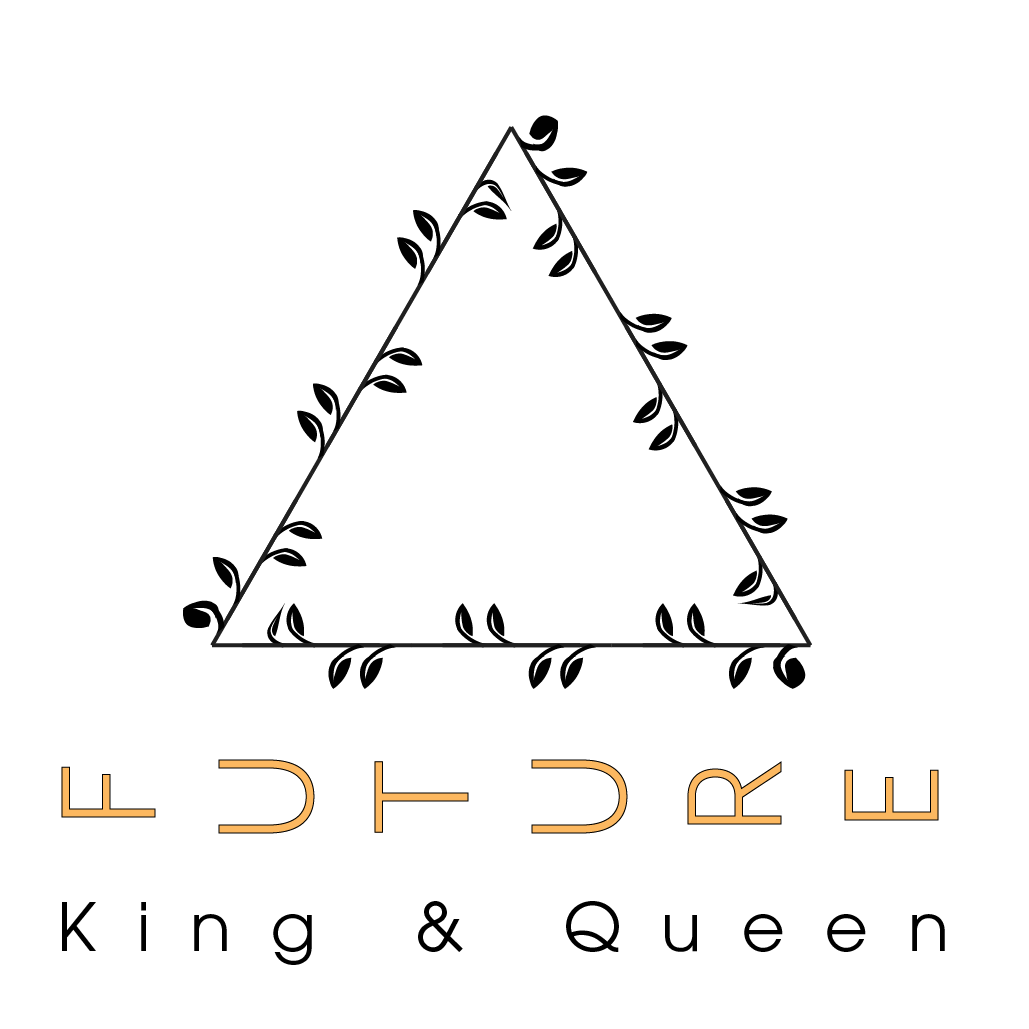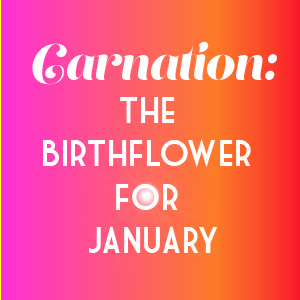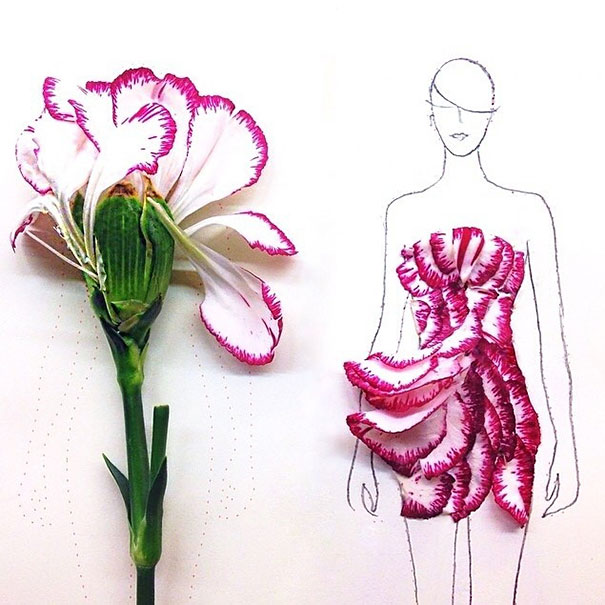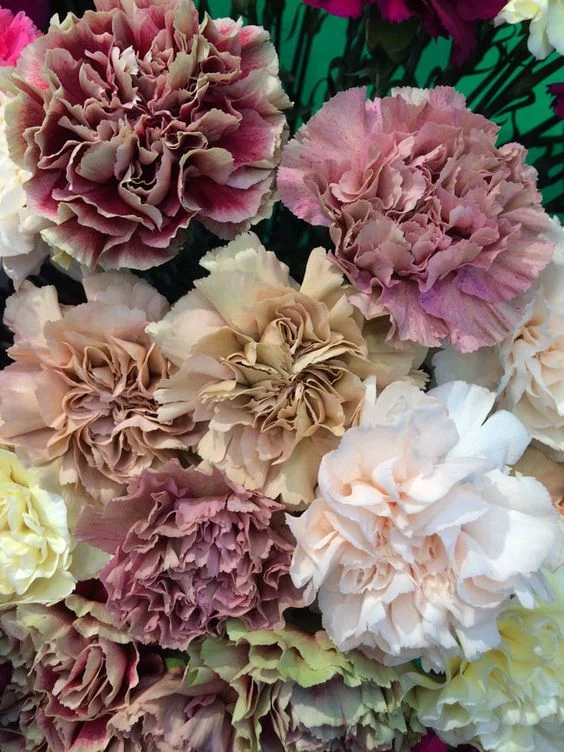Carnations in January :: Birthflower of the Month
In a charming custom popular in the 19th century (& possibly dating right back to the days of Ancient Rome), flowers were assigned to each month as a Birth Flower. The notion being, that if a person was born in a particular month, they would display the same characteristics as their attributed flower.
While we're not too sure about the logic behind that, we do rather love the romantic notion of having one's very own birth flower - if nothing else, it would be a thoughtful gift for the birthday person to receive either the flowers themselves, or goods made from them.
So we're kicking off the New Year with January's flower, the humble and old-fashioned Carnation. Read on to discover more about this highly scented flower which is much valued for its clove fragrance...
CARNATIONS:
Love, fascination & distinction.
Carnations, in general, symbolise love, fascination and distinction - meaning, if you were to give somebody a bunch of carnations, the intended implied message is that you find that person fascinating and distinctive, and that you love them.
However, different coloured carnations carry extra meanings, so it can get a little more cryptic if you choose to play Miss Marple. Red means deep love, white is good luck, striped can convey regret. Or they could just convey beauty in their own right, as this gorgeous bunch of ruffled orange and pink ones does.
Botanical Background
Dianthus caryophyllus, better known as Carnations or Clove Pinks, are a herbaceous perennial plant, producing multi-petaled flowers with a distinctive clove scent.
Mentioned in Ancient Greek texts (some 2000 years ago), the word Carnation is derived from the Greek word "dios" (divine) and "anthos" (flower). They are thought to have originated in the Mediterranean but as they were so popular throughout Europe, the Middle East and India from at least 2000 years ago, their exact origin is unclear.
The plants are very easy care, assuming they have access to full sun and a well-drained soil. They are quite low growing, and fairly quiet in appearance. But when the plant erupts into flowers, especially in summer, a walk past them in the garden will entice walkers to hunt in search of the fabulous perfume.(They actually flower for most of the year in warm climates, so are therefore available all year round in florists.)
Carnations were very popular as button hole flowers in the 19th century, possibly because of their perfume but also possibly because they keep quite well out of water for a reasonable amount of time.
The leaves are a very pretty grey-green, and the original flowers were a pink-purple, but newer varieties come in white, red, yellow and even green.
Decades of breeding for colour at the expense of perfume lead to the ubiquitous use of the carnation as a "supermarket flower" without perfume - but it's worth hunting out the old fashioned heirloom varieties because the clove scent is truly heavenly.
Massed together, carnations look romantic in their own company - no other flowers required.
Edible Blooms
Amongst their other charms, Carnations deserve a place at the dining table, because the petals are edible. Scattered over a cake or on top of a bright green salad, the ruffled petals have a gentle quality which evokes lanquid Edwardian afternoons.
An orange-poppy seed cake, resplendent with a berry glaze and scattered with fresh edible dianthus blooms, which would make a very fitting Birthday Cake for a person born in January. (vegan recipe)
- scatter Dianthus petals over a crisp mesclun lettuce salad, toss with walnut oil & raspberry vinegar
- freeze into ice cubes for summer drinks
- infuse white wine vinegar with fresh petals, leave to steep for 1 week then strain & decorate bottle with dried Dianthus petals
- stir petals through a fresh fruit salad to impart a clove aroma and flavour
- make a champagne syrup by dissolving powdered sugar in sparkling wine or champagne, then pouring cooled mixture into popsicle moulds. When slightly set, push fresh Carnation petals into the moulds, to create magical champagne icicles
Medicinal Uses for Carnations
Carnation petals have been used as a tea for centuries, especially as a medicine for insomnia, fatigue, stress or nervousness. The tea was traditionally used in Ancient China as a relaxant, and in Medieval Europe as both a tonic to improve the immune system and relieve pain.
Carnation Tea
If you're lucky enough to have a garden and can grow this old fashioned flower, try drying some of the whole flower heads and then brewing them up either on their own or mixed with black tea. Depending on the intensity of the flowers, it can be a heady, sensual brew - best served black.
There is so much more to this beautiful little flower than the sad association it has garnered through over production of the scentless supermarket flower.
If you can source out the heady varieties, they are incredible when simply massed in a vase, where they will scent the room beautifully. And if you know somebody who has a birthday this January, a little pot of them, a cake decorated with the fragrant petals, or a generous bunch of them would make a really thoughtful and timely gift.
Check back throughout the year, as we reveal each month's special birth flower.
Image credits, all via - fashion illustrations by Grace Ciao.









